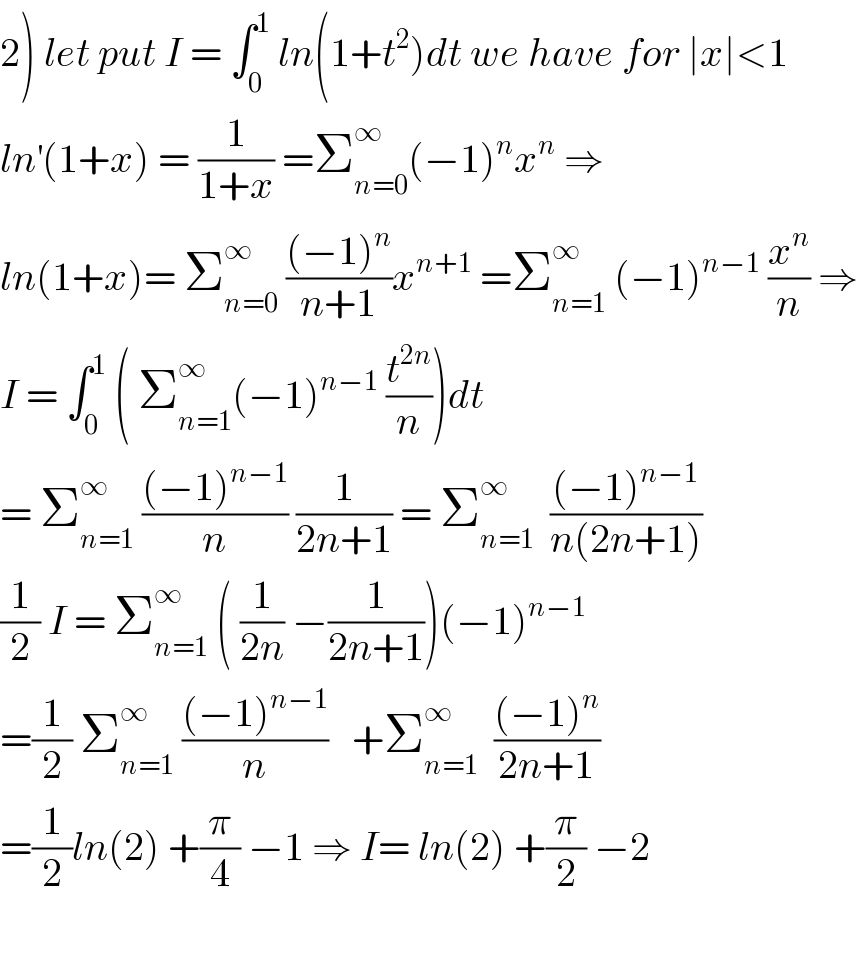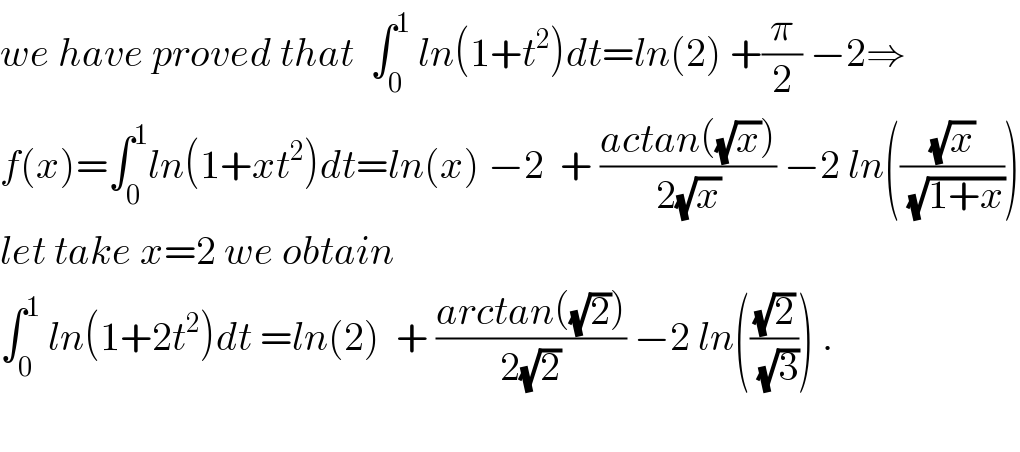
Question and Answers Forum
Question Number 31502 by abdo imad last updated on 09/Mar/18

Commented byabdo imad last updated on 15/Mar/18
![we have f^′ (x)= ∫_0 ^1 (t^2 /(1+xt^2 ))dt =(1/x) ∫_0 ^1 ((xt^2 )/(1+xt^2 ))dt =(1/x) ∫_0 ^1 ((1+xt^2 −1)/(1+xt^2 ))dt = (1/x) −(1/x) ∫_0 ^1 (dt/(1+xt^2 )) ch.(√x) t=u give ∫_0 ^1 (dt/(1+xt^2 )) = ∫_0 ^((√x) ) (1/(1+u^2 )) (du/((√x) )) =(1/((√x) )) ∫_0 ^(√x) (du/(1+u^2 )) = (1/(√x)) artan((√x)) ⇒ f^′ (x)= (1/x) −((arctan((√(x))))/(x(√x) )) ⇒ f(x)=ln∣x∣ −∫_1 ^x ((arctan((√t)))/(t(√t))) dt +λ λ=f(1)=∫_0 ^1 ln(1+t^2 )dt so f(x)=ln(x) −∫_1 ^x ((arctan((√(t))))/(t(√t))) dt +∫_0 ^1 ln(1+t^2 )dt ch.(√t)=u give ∫_1 ^x ((arctan((√t)))/(t(√t)))dt= ∫_1 ^(√x) ((arctanu)/u^3 ) (2u)du =2 ∫_1 ^(√x) ((arctanu)/u^2 )du =2( [−(1/u)arctanu]_1 ^(√x) +∫_1 ^(√x) (du/(u(1+u^2 )))) =2((π/4) −((arctan((√x)))/(√x)))+2 ∫_1 ^(√x) (du/(u(1+u^2 ))) but ∫_1 ^(√x) (du/(u(1+u^2 ))) =∫_1 ^(√x) ((1/u) −(u/(1+u^2 )))du =[ln(u)−(1/2)ln(1+u^2 )]_1 ^(√x) =[ ln( (u/(√(1+u^2 ))))]_1 ^(√x) =ln(((√x)/(√(1+x)))) −ln((1/(√2)))=ln( ((√x)/(√(1+x)))) +ln((√(2))) finally f(x)= ln(x)−(π/2) + ((arctan((√x)))/(2(√x))) −2ln(((√x)/(√(1+x)))) −ln(2) +∫_0 ^1 ln(1+t^2 )dt .](Q31854.png)
Commented byabdo imad last updated on 15/Mar/18

Commented byabdo imad last updated on 15/Mar/18

| ||
Question and Answers Forum | ||
Question Number 31502 by abdo imad last updated on 09/Mar/18 | ||
 | ||
Commented byabdo imad last updated on 15/Mar/18 | ||
![we have f^′ (x)= ∫_0 ^1 (t^2 /(1+xt^2 ))dt =(1/x) ∫_0 ^1 ((xt^2 )/(1+xt^2 ))dt =(1/x) ∫_0 ^1 ((1+xt^2 −1)/(1+xt^2 ))dt = (1/x) −(1/x) ∫_0 ^1 (dt/(1+xt^2 )) ch.(√x) t=u give ∫_0 ^1 (dt/(1+xt^2 )) = ∫_0 ^((√x) ) (1/(1+u^2 )) (du/((√x) )) =(1/((√x) )) ∫_0 ^(√x) (du/(1+u^2 )) = (1/(√x)) artan((√x)) ⇒ f^′ (x)= (1/x) −((arctan((√(x))))/(x(√x) )) ⇒ f(x)=ln∣x∣ −∫_1 ^x ((arctan((√t)))/(t(√t))) dt +λ λ=f(1)=∫_0 ^1 ln(1+t^2 )dt so f(x)=ln(x) −∫_1 ^x ((arctan((√(t))))/(t(√t))) dt +∫_0 ^1 ln(1+t^2 )dt ch.(√t)=u give ∫_1 ^x ((arctan((√t)))/(t(√t)))dt= ∫_1 ^(√x) ((arctanu)/u^3 ) (2u)du =2 ∫_1 ^(√x) ((arctanu)/u^2 )du =2( [−(1/u)arctanu]_1 ^(√x) +∫_1 ^(√x) (du/(u(1+u^2 )))) =2((π/4) −((arctan((√x)))/(√x)))+2 ∫_1 ^(√x) (du/(u(1+u^2 ))) but ∫_1 ^(√x) (du/(u(1+u^2 ))) =∫_1 ^(√x) ((1/u) −(u/(1+u^2 )))du =[ln(u)−(1/2)ln(1+u^2 )]_1 ^(√x) =[ ln( (u/(√(1+u^2 ))))]_1 ^(√x) =ln(((√x)/(√(1+x)))) −ln((1/(√2)))=ln( ((√x)/(√(1+x)))) +ln((√(2))) finally f(x)= ln(x)−(π/2) + ((arctan((√x)))/(2(√x))) −2ln(((√x)/(√(1+x)))) −ln(2) +∫_0 ^1 ln(1+t^2 )dt .](Q31854.png) | ||
Commented byabdo imad last updated on 15/Mar/18 | ||
 | ||
Commented byabdo imad last updated on 15/Mar/18 | ||
 | ||